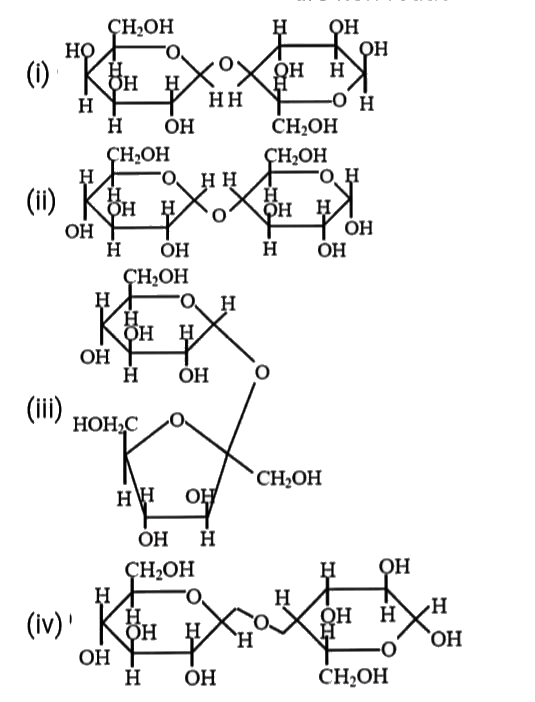Which of the following is not reducing sugar.
Sucrose
Glucose and fructose
Fructose
maltose
The correct Answer is:1
To determine which of the following sugars is not a reducing sugar, we need to understand the concept of reducing sugars and analyze each option provided.
1. Understanding Reducing Sugars:
- Reducing sugars are carbohydrates that can donate electrons to another chemical, thus reducing it. This typically occurs because they have a free anomeric carbon (the carbon that is part of the hemiacetal or hemiketal structure).
2. Analyzing Each Option:
- Option A: Sucrose
- Sucrose is a disaccharide composed of glucose and fructose. In its structure, both anomeric carbons (from glucose and fructose) are involved in the glycosidic bond, meaning they are not free. Therefore, sucrose does not have a free anomeric carbon and is classified as a non-reducing sugar.
- Option B: Glucose
- Glucose is a monosaccharide and has a free anomeric carbon. Therefore, glucose is a reducing sugar.
- Option C: Fructose
- Fructose is also a monosaccharide with a free anomeric carbon. Thus, fructose is a reducing sugar as well.
- Option D: Maltose
- Maltose is a disaccharide made of two glucose units. In its structure, one anomeric carbon is free, allowing maltose to act as a reducing sugar.
3. Conclusion:
- Based on the analysis, the only sugar that is not a reducing sugar is sucrose.
Final Answer:
Sucrose is not a reducing sugar.
---
- Reducing sugars are carbohydrates that can donate electrons to another chemical, thus reducing it. This typically occurs because they have a free anomeric carbon (the carbon that is part of the hemiacetal or hemiketal structure).
- Option A: Sucrose
- Sucrose is a disaccharide composed of glucose and fructose. In its structure, both anomeric carbons (from glucose and fructose) are involved in the glycosidic bond, meaning they are not free. Therefore, sucrose does not have a free anomeric carbon and is classified as a non-reducing sugar.
- Option B: Glucose
- Glucose is a monosaccharide and has a free anomeric carbon. Therefore, glucose is a reducing sugar.
- Option C: Fructose
- Fructose is also a monosaccharide with a free anomeric carbon. Thus, fructose is a reducing sugar as well.
- Option D: Maltose
- Maltose is a disaccharide made of two glucose units. In its structure, one anomeric carbon is free, allowing maltose to act as a reducing sugar.
- Based on the analysis, the only sugar that is not a reducing sugar is sucrose.
Sucrose is not a reducing sugar.
Topper's Solved these Questions
- BOOK - RESONANCE ENGLISHCHAPTER - BIOMOLECULES & POLYMEREXERCISE - ORGANIC CHEMISTRY(Biomolecules & Polymer)34videos
BIOMOLECULES & POLYMER
- BOOK - RESONANCE ENGLISHCHAPTER - BIOMOLECULESEXERCISE - Advanced Level(Part II)33videos
BIOMOLECULES
- BOOK - RESONANCE ENGLISHCHAPTER - CARBONYL COMPOUNDS (ALDEHYDES & KETONES ) & CARBOXYLIC ACID EXERCISE - Part -IV23videos
CARBONYL COMPOUNDS (ALDEHYDES & KETONES ) & CARBOXYLIC ACID
Similar Questions
Knowledge Check
- Question 1 - Select One
Which of the following is non-reducing sugar ?
AGlucoseBSucroseCMaltoseDLactose - Question 2 - Select One

Which of the following are the reducing sugars?AX and YBX and ZCY and ZDAll of these - Question 3 - Select One
Which one of the following is a reducing sugar?
AA) MaltoseBB) CelluloseCC) GlucoseDD) Sucrose
Which of the following is not a reducing agent ?
View SolutionWhich of the following are non - reducing sugars ?
View SolutionWhich of the following is/are non-reducing sugars?
View SolutionWhich one of the following is non-reducing sugar ?
View SolutionWhich of the following is not a reducing oxide ?
View Solution


